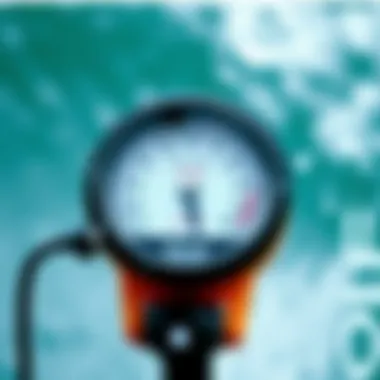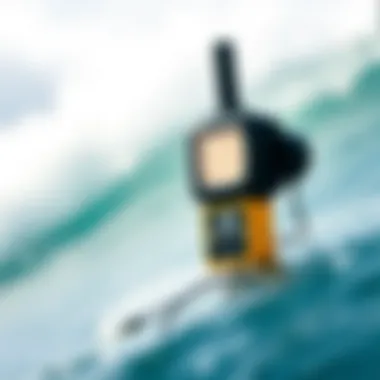Instruments for Measuring Wind Speed in Surfing


Intro
Understanding wind conditions is critical for surfers seeking the perfect wave. Different surfing spots react uniquely to changes in wind speed, and the right instruments can make all the difference for a rewarding experience on the water. Accurate wind measurements provide surfers with the necessary data to make informed decisions about when and where to surf.
In this article, we’ll unravel the various tools and instruments available to measure wind speed, tailored specifically for surfing enthusiasts. From handheld devices to advanced monitoring systems, each plays a role in shaping surf conditions.
With the aid of technology, surfing can be optimized for safety and performance. We aim to shed light on these essential instruments, the methodologies behind them, and how they influence the surfing lifestyle.
Surfing Techniques
Mastering the Basics
Learning to read wind conditions is as fundamental as any surfing technique. Before even catching your first wave, understanding how wind affects ocean surface and wave formation is crucial. Various types of wind measurement tools help inexperienced surfers grasp these elements quickly. In the beginning, it’s essential to familiarize yourself with anemometers and sail indicators.
- Anemometers are devices that measure wind speed. They come in various forms, from handheld versions to more comprehensive digital models. For beginners, a basic handheld anemometer can aid in assessing the local wind speed before heading out.
- Sail indicators provide additional context to wind direction. These simple tools help to visualize how the wind flows over the surface of the water, directing surfers to where they may find favorable conditions.
Advanced Maneuvers
For seasoned surfers, knowing the ins and outs of wind patterns enhances performance significantly. Advanced tools like smartphone apps and website resources have gained traction among the surfing community. Many of these apps connect to weather stations, offering real-time data on gust patterns and wind predictions.
Here are some features that can take your riding experience to the next level:
- Live Wind Speed Monitoring: Applications like Windy or Surfline offer wind speed updates in real-time, ensuring you're never caught off guard.
- Historical Data Analysis: Reviewing past wind conditions can help predict future wave formations. This aspect is particularly helpful for those who frequently surf the same spots.
- Integrated Oceanographic Models: Some advanced tools calculate swell, tide, and wind interactions, giving surfers a comprehensive understanding of ocean dynamics.
“Understanding wind patterns takes time, but the right tools can fast-track your learning and improve your surfing.”
To truly master wind conditions, both beginners and experts should regularly engage with these instruments. They not only inform decisions but can also significantly enhance the overall surfing experience.
Surfing Lifestyle
Ultimately, wind speed measurement isn’t just about catching the perfect wave; it's also about understanding its role in the broader surfing lifestyle. Surfing communities thrive on shared knowledge, making the role of instruments vital for fostering a culture centered around knowledge and safety.
Sustainable Surfing Practices
In recent years, there has been a push toward sustainable surfing practices that recognize the effects of weather patterns and ocean changes. Surfers are encouraged to utilize tools that not only aid immediate needs but also contribute to broader environmental concerns. Technology that monitors wind and waves can provide data that supports marine conservation efforts.
Surf Culture Around the World
Global surfing culture is constantly evolving, influenced by local wind conditions and trends. Different regions have their specific tools that surfers prefer, showcasing how integral these instruments are to the lifestyle. From the vibrant beaches of Hawaii to the legendary surf breaks in Australia, each locale offers unique relationship dynamics with wind conditions.
By acknowledging the significance of wind speed measurement in surfing, enthusiasts can deepen their connection to both the sport and its surrounding environment.
Preamble to Wind Measurement
Understanding wind measurement is vital, particularly for surf enthusiasts looking to ride the waves at their best. Wind speed affects not just how well a surfer can catch a wave but influences the overall surfing experience. The right conditions can make a day at the beach feel like a dream, while unfavorable winds can turn a session into a struggle.
Importance of Wind Speed in Surfing
For surfers, wind speed significantly impacts wave formation and stability. Higher winds can create choppy conditions, which may lead to unpredictable waves, making it tougher to paddle out or execute maneuvers. Conversely, lighter winds often contribute to smoother surf, yielding cleaner waves that allow more control over movement. Thus, knowing the wind speed can help surfers plan their outing to coincide with the ideal conditions. An adage in the surfing community goes, "Timing the tide with the wind makes all the difference."
Another critical aspect is the determination of breaks; certain spots are optimized for specific wind directions. For instance, offshore winds can groom waves, whereas onshore winds may batter them and render your ride less enjoyable. In summary, gauging wind speeds and understanding their nuances helps surfers make informed choices for better outings.
How Wind Influences Surf Conditions


Wind isn’t a singular force; it works in tandem with other elements to shape surf conditions. For starters, wind plays a pivotal role in creating swells. When winds blow consistently over a vast area of water, they generate energy that travels—this energy manifests as swell toward the coast. The size and power of the waves depend on the wind duration and distance; two surfers might find themselves at very different spots depending on the wind patterns.
Another important factor is the wind's direction.
- Offshore winds (blowing from land to sea) are generally favorable, as they hold up the wave faces and keep them clean.
- Onshore winds (blowing from sea to land) disrupt the wave form and often lead to messy surf conditions.
Understanding these intricacies helps surfers to choose their spots accordingly. Often, local knowledge regarding prevailing winds can make the difference between a successful and a lackluster day on the water.
For the savvy surfer, understanding the wind’s influence could be the secret sauce for achieving that perfect ride.
Types of Wind Measurement Instruments
Understanding the different types of wind measurement instruments is crucial for surfers who want to fine-tune their sessions based on prevailing wind conditions. The right tools not only help in gauging the wind speed but also provide insights into its direction, which is vital for those looking to catch the best waves. Moreover, being knowledgeable about these instruments allows surfers to anticipate changes in wind conditions that could affect their surf experience.
Anemometers: The Standard Tool
Definition and Functionality
An anemometer is a device specifically designed to measure wind speed. It works by capturing the wind in a way that translates its velocity into measurable data. Typically, these instruments feature rotating cups or blades that spin faster in stronger wind. This characteristic makes anemometers popular among surfers, as they provide accurate and immediate feedback on wind conditions. What sets them apart from other instruments is their ability to deliver real-time data, which is vital when choosing the optimal time to surf.
Types of Anemometers
There are a few different types of anemometers, each with unique features that cater to specific needs. The most common ones include:
- Cup Anemometers: Comprising three or four cups fixed to horizontal arms, these instruments spin with the wind, which provides highly reliable speed readings.
- Vane Anemometers: These combine a fan with a measuring device, which is great for measuring both wind speed and direction.
- Digital Anemometers: These advanced devices often include digital displays and data logging capabilities, appealing to tech-savvy surfers.
Each type offers distinct advantages. For example, cup anemometers are known for their robustness and straightforward functionality. However, digital models typically provide enhanced precision, aiding surfers in making informed decisions.
Applications in Surfing
Anemometers are invaluable for surfing applications. They not only help surfers know if conditions are right but also allow for better planning around tide and wave behavior. By understanding how wind conditions affect surf spots, surfers can maximize their time in the water. The unique ability of these instruments to measure wind speed with high precision means surfers can work on their timing, ensuring they catch the perfect wave.
Wind Vanes: Directional Measurement
Working Principle
Wind vanes serve as a complementary instrument to anemometers by indicating wind direction. Typically featuring a rotating arrow or blade that aligns with the wind, these devices are crucial in understanding how wind aligns with surf conditions. Their primary advantage lies in their simplicity – they provide a straightforward indication of wind direction, helping surfers to choose ideal spots based on local meteorological patterns.
Relevance to Surf Spots
The relevance of wind vanes can’t be overstated. They inform surfers of wind changes that can affect surf quality, including onshore and offshore wind influences. For instance, an onshore wind can flatten waves while an offshore wind may help in forming crisp sets. This directional information allows surfers to choose the right board and adjust their techniques according to the prevailing conditions.
By knowing how wind plays with surf spots, surfers can position themselves better, making their overall experience more enjoyable. It's this combination of understanding speed and direction that enables surfers to refine their approach and improve performance.
Digital vs. Analog Instruments
Measuring wind speed is a critical aspect for surfers looking to make the most of their time on the water. When it comes to choosing the right instruments, the debate often narrows down to digital versus analog devices. Each type has its own merits and demerits; understanding them can greatly influence a surfer's experience and success.
Advantages of Digital Wind Speed Meters
Precision and Ease of Use
Digital wind speed meters represent the cutting edge in measuring technology. These devices utilize advanced sensors to produce readings with incredible precision. The simplicity of their use is another feather in their cap. Surfers can easily read wind speeds on an LCD or LED screen, making for a hassle-free experience. The key characteristic here is immediacy; one can quickly glance and get up-to-date readings. This is particularly beneficial for those who need timely information while preparing for a surf session.


Unique features of digital meters often include backlit displays, which make them usable even in low-light conditions, and data logging capabilities, allowing surfers to track conditions over time. However, some may point out that these gadgets can be sensitive to moisture and temperature changes, potentially affecting accuracy. It’s a trade-off worth considering for those who prioritize modern tech.
Features for Surfers
Digital meters also come equipped with features tailored specifically for surfers. For instance, many electronic devices include Bluetooth connectivity, allowing users to sync data to their smartphones. This interconnectivity is a game changer, as surfers can access real-time updates from their favorite surf-centric applications.
Another standout aspect is their ability to record maximum and average wind speeds, which is immensely helpful in analyzing surf conditions after sessions. Yet, the reliance on batteries suggests that users should remain mindful of power reserves, especially on longer trips.
The Charm of Analog Devices
Historical Context
Analog devices have stood the test of time, existing long before digital counterparts became the norm. These classic tools often evoke nostalgia among surfers and some might argue they provide a more 'authentic' experience. Their simplicity is one of their defining traits; no batteries or complex settings. Just good old-fashioned mechanics.
The unique feature of analog anemometers is that they rely on mechanical movement to measure wind speed, offering a tactile dimension absent in digital models. One downside, though, is that they tend to be less precise than digital meters and can be affected by environmental factors. While it’s easier to see a digital number climbing on the screen, analog numbers can be tricky to decipher in windy conditions.
User Experience
The user experience of analog devices is often cited as more engaging. Many surfers appreciate the straightforward nature of reading a dial compared to interpreting digital readouts or navigating through app interfaces. The physical interaction with an analog device can even enhance the surfing experience, offering a connection to the elements that digital gadgets sometimes lack.
Yet, creativity in representing wind data can be seen as both a strength and a drawback. For instance, while students of meteorology may find it enjoyable to interpret wind speed from a dial, others may find frustration in discerning its meaning while juggling surf gear.
"Choosing the right instrument is like selecting a surfboard; it’s about matching the tool to your style and needs."
In sum, both digital and analog wind speed measuring instruments have their places in the hearts of surfers. Whether leaning towards the modernity of digital devices or the timeless charm of analog ones, the final choice often lies in personal preference and specific surfing needs.
Key Features to Consider
When it comes down to selecting the right wind measurement instruments for surfing, understanding key features is crucial. Surf conditions can swing quickly, and surfers need reliable data at their fingertips for better decision-making. This section dives into two important considerations: calibration and accuracy, along with portability for surfers.
Calibration and Accuracy
Calibration is essential for any instrument measuring wind speed, particularly in the surf environment where conditions change often and spontaneously. An improperly calibrated device can lead to misleading data, causing surfers to misjudge the waves or wind patterns. Just like a seasoned surfer checks his surfboard before heading into the waves, ensuring your wind speed meter is accurately calibrated can save you a lot of trouble.
The process typically involves comparing the instrument's readings against a known standard. Regular calibration helps maintain accuracy and reliability, which is especially vital for surf forecasts. Surfers rely heavily on precise measurements to choose the right time and spot to catch waves, making this a non-negotiable feature.
Here are some crucial points to consider:
- Frequency of Calibration: Depending on your usage, calibrating your device monthly, or even weekly, could be beneficial. High variability in your local surf conditions often necessitates ongoing adjustments.
- Calibration Standards: Look for devices that are compliant with international standards so you can trust their accuracy. Instruments that allow you to calibrate manually can also add a layer of customization according to local conditions.
"An accurate wind speed measurement is the difference between a good day in the surf and a wasted trip to a beach that’s flat."
Portability for Surfers
Portability is another critical consideration when choosing instruments for measuring wind speed. If the instrument is bulky or heavy, it likely won't make the cut for most surfers. After all, carrying a heavy load to a surf spot can feel like dragging an anchor along.
Surfers often travel light, balancing essentials like a wetsuit, surfboard, and beach gear. Therefore, wind measurement devices need to accommodate that lifestyle. Many modern devices come in compact forms that easily fit into a backpack or a beachside cooler. Ultimately, the goal is to ensure that you're not bogged down by cumbersome gear.
Here are features that enhance portability:
- Compact Design: Look for anemometers and other tools that prioritize a lightweight and compact structure.
- Weather Resistance: Surfers often find themselves in rugged environments. Instruments that are splash-proof or weather-tight can withstand the unpredictable nature of the surf.
- Ease of Use: A device with a simple interface can make it easier to quickly gather data and get on with riding waves rather than fiddling with complicated gadgets.
In summary, both calibration and portability play significant roles in the selection of wind measurement tools for surfing. Without these features, any device may just gather dust in a kit instead of keeping surfers informed on the best conditions to hit the waves.


Maintaining Wind Measurement Instruments
For surfers, knowing how to read wind conditions can mean the difference between a thrilling ride and a frustrating day stranded on the beach. Just as an athlete relies on well-maintained gear, wind measurement instruments need regular care to provide accurate readings. This section dives into the importance of maintaining these tools, ensuring they serve surfers reliably through wind changes.
Regular Maintenance Practices
Routine upkeep of wind measurement instruments is not merely an option; it's essential. These devices operate in varying conditions, from sunny shores to stormy tides. Thus, adopting consistent maintenance practices can enhance longevity and accuracy. Here are some pivotal practices:
- Cleaning: Dust and salt can accumulate on sensors and screens. Wiping them down with a soft cloth after each session ensures that readings remain clear and accurate.
- Calibration: Depending on the use, instruments should be recalibrated regularly to account for any sensor drift. This may involve following the manufacturer’s guidelines or using calibration kits.
- Storage: After a day out, store devices in a cool, dry place. Extreme temperatures and moisture can damage sensitive parts.
- Battery Checks: Regularly checking and replacing batteries, especially if using digital devices, can prevent unexpected outages in the middle of a session.
By instituting these practices, surfers can foster trust in their instruments, knowing they’ll deliver reliable information when it counts most.
Troubleshooting Common Issues
Even the best instruments can face hiccups now and then. Understanding common problems can save surfers from being caught off guard. Here are some frequent issues along with their possible solutions:
- Inaccurate Readings: If wind speed appears far from reality, it may be due to debris obstructing the sensor. Clean it off and check the calibration settings.
- Device Not Turning On: For digital meters, this often comes down to dead batteries. Test with a new set or ensure the battery contacts are clean.
- Erratic Measurements: Sudden fluctuations might indicate a damaged sensor or a strong gust affecting the readings. Inspect the device and, if necessary, consult the manual for repair options.
- Display Errors: If the screen freezes or shows incorrect data, a quick reset might clear the issue. If the error persists, a factory reset or a technician’s help may be needed.
By knowing these troubleshooting techniques, surfers can quickly address potential issues and get back to catching the next wave rather than worrying over faulty gear.
"A good surf experience is like a good relationship; if you take care of it, it'll be there when you need it."
Real-World Applications for Surfers
Understanding wind speed is like having a secret key that unlocks the door to optimal surfing conditions. For surfers, wind can either make or break a session at sea. Thus, leveraging wind data is more than just trivia; it’s about enhancing one’s surfing experience and maximizing the fun in the water.
Using Wind Data for Surf Forecasting
Surfers often turn to various weather forecasts, but harnessing wind data specifically can provide crucial insights that merely looking at the surf report might miss. By analyzing local wind patterns, surfers can gauge when and where the waves will be at their best.
For instance, a lot of surfers keep an eye on how wind behaves along particular coastlines. The following elements are essential when using wind data for forecasting:
- Wind Speed and Surf Quality: Faster, offshore winds typically smooth out the surface of the water, setting the stage for cleaner and more organized waves. Conversely, onshore winds can create choppy conditions and ruin wave quality.
- Timing: Wind patterns change throughout the day. Early mornings might bring glassy conditions, while afternoon breezes can disrupt the calm. By noting the peak wind speeds at different times, surfers can determine the prime window for riding.
- Weather Systems: Sometimes, looking at broader weather patterns, like the approach of a storm, can inform surfers about potential swell and wind interactions. A well-timed storm could mean some of the best surf when the winds settle back into favorable patterns.
Understanding how to interpret wind data can enhance one’s ability to forecast when to hit the surf, significantly impacting the overall ride.
Understanding Local Wind Patterns
Every surfing spot has its quirks. Local geography, coupled with prevailing winds, creates unique conditions that surfers need to understand.
- Topography's Role: The landscape can significantly influence wind behavior. For instance, coastal cliffs might channel winds in a way that can create perfect wave conditions further down the beach. Surfers who take the time to watch how wind interacts with local topography are often the ones scoring the best waves.
- Seasonal Changes: Winds can change drastically with seasons. For example, a warm summer might bring consistent offshore winds early in the morning and unpredictable gusts later in the day. Taking note of these seasonal variations is crucial for any devoted surfer keen on catching waves consistently.
- Predictive Patterns: Over time, many surfers document wind patterns at specific locations, creating an informal database of what works when. This anecdotal data is invaluable, as it maps out the correlation between wind and wave conditions, allowing surfers to anticipate and adapt their plans accordingly.
By having an astute awareness of both local wind patterns and the dynamics of wind data, surfers can elevate their game, getting the most out of every outing. The ocean tends to be a fickle friend, but knowing its language—even in terms of wind—can make a world of difference in a surfer's experience.
Epilogue
Understanding the tools that measure wind speed is critical for surfers who want to enhance their riding experiences. These instruments provide vital data that influences not only surf conditions but also safety and performance. Knowing how to choose and utilize these tools can significantly change how one interacts with the ocean.
The Future of Wind Measurement in Surfing
As technology evolves, wind measurement instruments are experiencing a transformation. Innovations in sensor technology and data transmission are making devices more accurate and user-friendly. For instance, smart anemometers now connect to smartphones through Bluetooth, allowing surfers to access real-time data on their devices. These advancements can make a world of difference when deciding whether to hit the waves.
Furthermore, software advancements are integrating machine learning to predict wind patterns more effectively. As data collection improves, surfers will have access to more precise forecasts, making it easier to pick the perfect time to surf. As we look ahead, we anticipate that wind measurement devices will become even more compact and versatile, possibly integrating GPS functionalities to assist in navigation and tracking.
Final Thoughts for Surf Enthusiasts
For surfers, understanding wind speed is not just about the thrill of the ride; it's about making informed choices that enhance safety and enjoyment. By familiarizing with the instruments available, surfers can better grasp the relationship between wind conditions and ocean dynamics. Each device offers something unique, whether anyone prefers an anemometer or a wind vane.
When you're out there riding the waves, remember that the right tools can turn an average day into an extraordinary one. Stay tuned to local weather forecasts and invest a bit of time exploring different measurement instruments. The more knowledgeable you are about wind conditions, the better equipped you'll be to chase those ideal surf days.















